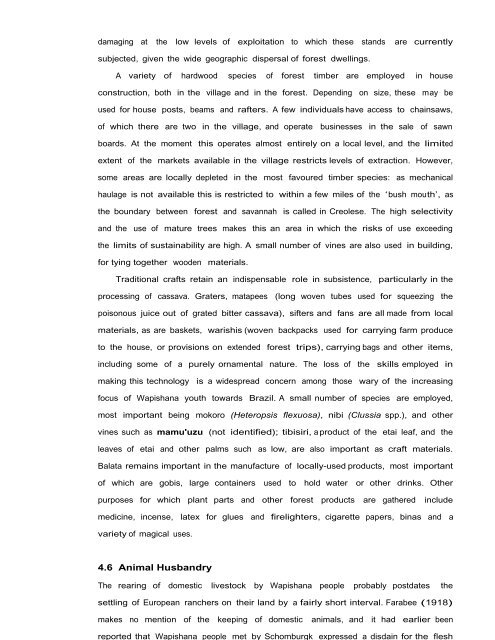Ethnoecology, Resource Use, Conservation And Development In A ...
Ethnoecology, Resource Use, Conservation And Development In A ...
Ethnoecology, Resource Use, Conservation And Development In A ...
Create successful ePaper yourself
Turn your PDF publications into a flip-book with our unique Google optimized e-Paper software.
damaging at the low levels of exploitation to which these stands are currently<br />
subjected, given the wide geographic dispersal of forest dwellings.<br />
A variety of hardwood species of forest timber are employed in house<br />
construction, both in the village and in the forest. Depending on size, these may be<br />
used for house posts, beams and rafters. A few individuals have access to chainsaws,<br />
of which there are two in the village, and operate businesses in the sale of sawn<br />
boards. At the moment this operates almost entirely on a local level, and the limited<br />
extent of the markets available in the village restricts levels of extraction. However,<br />
some areas are locally depleted in the most favoured timber species: as mechanical<br />
haulage is not available this is restricted to within a few miles of the ‘bush mouth’, as<br />
the boundary between forest and savannah is called in Creolese. The high selectivity<br />
and the use of mature trees makes this an area in which the risks of use exceeding<br />
the limits of sustainability are high. A small number of vines are also used in building,<br />
for tying together wooden materials.<br />
Traditional crafts retain an indispensable role in subsistence, particularly in the<br />
processing of cassava. Graters, matapees (long woven tubes used for squeezing the<br />
poisonous juice out of grated bitter cassava), sifters and fans are all made from local<br />
materials, as are baskets, warishis (woven backpacks used for carrying farm produce<br />
to the house, or provisions on extended forest trips), carrying bags and other items,<br />
including some of a purely ornamental nature. The loss of the skills employed in<br />
making this technology is a widespread concern among those wary of the increasing<br />
focus of Wapishana youth towards Brazil. A small number of species are employed,<br />
most important being mokoro (Heteropsis flexuosa), nibi (Clussia spp.), and other<br />
vines such as mamu'uzu (not identified); tibisiri, a product of the etai leaf, and the<br />
leaves of etai and other palms such as low, are also important as craft materials.<br />
Balata remains important in the manufacture of locally-used products, most important<br />
of which are gobis, large containers used to hold water or other drinks. Other<br />
purposes for which plant parts and other forest products are gathered include<br />
medicine, incense, latex for glues and firelighters, cigarette papers, binas and a<br />
variety of magical uses.<br />
4.6 Animal Husbandry<br />
The rearing of domestic livestock by Wapishana people probably postdates the<br />
settling of European ranchers on their land by a fairly short interval. Farabee (1918)<br />
makes no mention of the keeping of domestic animals, and it had earlier been<br />
reported that Wapishana people met by Schomburgk expressed a disdain for the flesh


